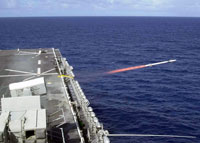The RIM-116
Rolling Airframe Missile (RAM) is a small, lightweight, infrared
homing surface-to-air missile in use by the United States Navy, German
Navy, Hellenic Navy, Egyptian Navy and South Korean Navy.
It is
intended primarily as a point-defence weapon against anti-ship cruise
missiles.
The missile
is named because it rolls during its flight to stabilise the flight path.
The onboard Mk 49 launcher installation weighs 5,777 kg (12,736lbs or
6.4 tons) and stores 21 missiles. The weapon cannot employ its own
sensors prior to firing so it must be integrated with a ship's combat
system, which directs the launcher at targets. On US ships it is
integrated with the AN/SWY-2 and Ship Self Defence System combat
systems.
The RIM-116 was developed by General Dynamics under a July 1976
agreement with Denmark and West Germany. (The General Dynamics missile
business was later acquired by Hughes Aircraft and is today part of
Raytheon.) The US Navy hopes to purchase 1,600 RAMs and 115
launchers to equip 74 ships. The RIM-116 is currently used on several
American and 25 German warships. Moreover, all new German Navy vessels
will be equipped with RAM, such as the new, stealthy Braunschweig
class corvettes, which will mount 2 RAM launchers per ship. The
Hellenic Navy has equipped the new Super Vita-class fast attack craft
and South Korea has also signed procurement contracts.
|
RIM-116 RAM Specifications |
|
Type |
Infrared
anti-missile missile |
|
Manufacturer |
Raytheon |
|
Weight |
73.5kg |
|
Warhead |
11.3kg blast fragmentation |
|
Length |
9ft (2.8m) |
|
Diameter |
5in (12.7cm) |
|
Performance |
Speed Mach 2 +, range 11
miles (7.5km), guidance passive radio frequency and infrared |

